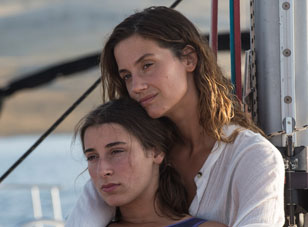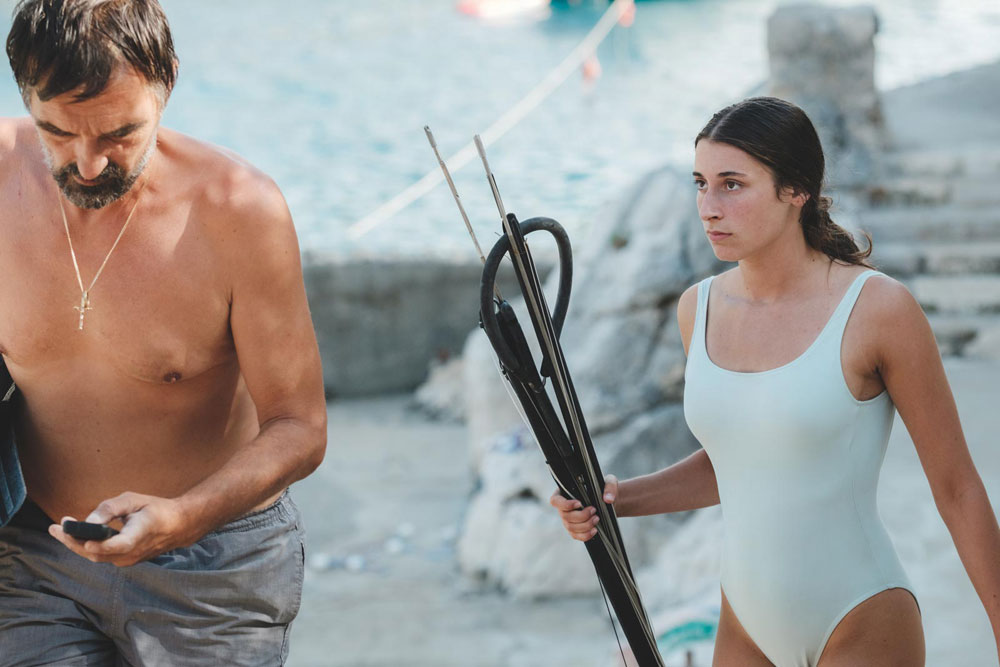“If you need to know everything upfront, you’ll never get off this land,” Javier (Cliff Curtis) can be heard telling Julija (Gracija Filipovic) in “Murina,” just after arriving at the island home off the coast of Croatia where the 19-year-old lives with her domineering father Ante (Leon Lucev) and her deferential mother Nela (Danica Curcic). Why anyone would want to leave may seem like a question when the scenery is unspeakably beautiful, which is ostensibly the reason for Javier’s visit when he brings the promise of potentially seeding the money required to build a resort for tourists, but after scraping by on a humble fisherman’s wages, a move to Zagreb is appealing to all of Julija’s family, who have gotten cabin fever in the open air when all of their most primal emotions from anger to arousal have been amplified by stress.
Although one wouldn’t be wrong to describe “Murina” as a delicious cross between Deniz Gamze Erguven’s galvanizing empowerment drama “Mustang” and Rene Clair’s psychosexual seaside thriller “Purple Noon,” it is somewhat futile to compare Antoneta Alamat Kusijanović’s feature debut to just about anything when it distinguishes itself early as a unique coming-of-age story in which the teenage feeling that everything has life-or-death consequences really does seem like it could come to pass for the headstrong Julija. Dutifully accompanying her father as he pulls out all the stops to try to unload his business, she may be the only daughter pleased to see her mother dancing with another man as it becomes clear that Javier isn’t only around to strike a real estate deal, and she looks on longingly at the carefree college kids from abroad who park their party yacht next to her house, wondering if she should just sneak off with them.
After first discovering the stoic Filipovic at just 13 years old for her short “Into the Blue,” Kusijanović built the fraught family dynamics in “Murina” around her as if preparing a sailboat for a storm, employing her considerable magnetism to lure one into all the treacherous territory “Murina” covers. With breathtaking underwater cinematography to capture Julija and Ante’s fishing trips where the natural beauty of the ocean stands in stark contrast to his constant inclination to belittle her, the film impressively conjures Julija’s inability to find stable ground even after she’s made it back to shore, sickened by how her parents behave and yet never fully sure of herself when the assumption at her age is that they should know better. Add in the fact that both she and her mother have been deprived of much attention from the opposite sex when Javier pulls up to dock and “Murina” has all the elements to explode, which could be said of its writer/director as well, who delivers and then some in this electrifying first feature.
Shortly after the film’s premiere as part of Directors’ Fortnight at Cannes, Kusijanovic spoke about how she found her way into her first feature on the back of her well-received short, as well as working with Filipovic and battling the elements to emerge triumphant with this engaging drama.

Basically, I was very, very interested in the interpersonal dynamics amongst children that are completely set free in this wild nature. They’re under the influence of their hormones and there are almost these Shakespearean relationships between the four kids. They act so maturely as adults and their relationship is so complex, I wanted to translate that to “Murina,” but I wanted adults to act like children. Julija is the main character [in both], so I wanted to give her wisdom beyond her age among these adults. I always gave her a little extra insight, but also being a teenager, that insight can deceive you — that’s something I loved to play with. Very often as teenagers, we are certain we know everything and the strength and the resilience is something we like to keep as adults but maybe such impulsiveness is good to withhold a bit.
Did the character of Julija change over the years as you stayed connected with Gracija in her formative years?
Character always changes when confronted with other actors. I like to observe the dynamics and stay flexible in preproduction, and once I’m in the shoot, I’m much less flexible to change things, but I like when the dynamics of the real people inform the movie. I wouldn’t say her character had changed, but some interpretations of it I definitely adapted to her as a person.
Some things you create and some things you really just need to find and it’s like that with nonactors, I believe. Sometimes you need to find and then adjust things around them because we are not talking about a craft, we are talking about something more raw.
I understand you grew up in this area – how did you think about how the location could play into the story?
Yes, if we are talking about cinematic and visual influences, for me, it’s always location. I was looking for the place that was completely bare without vegetation, nothing green. I wanted to just see grey and blue and I wanted the characters to be like raw meat, exposed to the sun, exposed to their true motives. What is hidden had to come out in that discomfort.
Did the weather cooperate? It’s gorgeous throughout.
The last day of shoot, we had a change of weather four times. [laughs] It was basically four seasons in one day. It was rainy in the morning, then super sunny and then we had a big, big storm — completely black sky — and then it was again sun in the evening, so that was a crazy day. We always had to be in tune with nature, and there’s a climate as well underwater that people don’t understand. It’s not so apparent, but it has its own currents that can make the camera not focus and things being blurred. Of course, the wind and waves above the water being in the boat – everything in the exterior really depending on the sun and the length of the day and all the non-nature elements, which is tourism, crowds – we were very…we didn’t have a backup safety plan. We were really there dancing with our environment.
Did “Into the Blue” prepare you well for the underwater shoots?
Definitely, I made all the mistakes on “Into the Blue” and I learned how to shoot underwater so much better on “Murina.” [laughs]
You’ve got an incredible cinematographer in “Never Rarely Sometimes Always” DP Hélène Louvart. What was it like working with her?
Hélène Louvart is the most incredible collaborator one can wish for. She’s this creative force, very mothering, very simple and very empathic, so I learned a lot from her and from that collaboration.
Was it important to bring on international collaborators? It looked like you really drew on cast and crew from around the world.
Yeah, that was very important. Also, myself being in and out of Croatia, I’m local, but I had some distance and all of this really informed how the movie speaks and how it is seen and its style.
What’s it like to get the film to Cannes?
It’s such a relief and so much happiness. As you know, we are all making films with a big crew. We are never alone and there’s a sense of both excitement, but a responsibility to the people that devote such a long time — more than a year or two — to the movie. Once the movie is actually accepted into a festival like Cannes, it means so much to everyone and also a lot to my country as well, especially in this year, a very, very complicated year in the film industry [when] many great films have not found their home yet and many festivals have been cancelled, so I’m so grateful.
“Murina” opens on July 8th in New York at the Metrograph with a national expansion to follow. A full schedule of theaters and dates is here.




